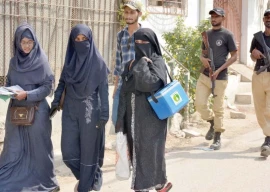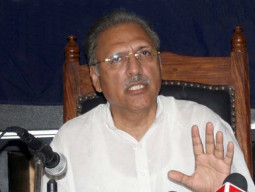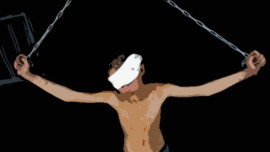
It is always awkward attending a ceremony for a deceased person. There is a feeling of intrusion that weighs down as you avoid the misty smiles of the friends and family. At Ussman Ghauri’s tribute at the Indus Valley School (IVS) Gallery that discomfort dissipated within minutes.
On Saturday, the Canvas Gallery and IVS hosted the tribute that honoured Ghauri as an artist, friend and teacher — and the ceremony was as complete as could be.
The artist — best described by his peers as an individual who was “positive, inspiring and always had a solution” — passed away of a heart attack on April 9. He was one of the favourite teachers of the school and the first curator of their gallery.
As Ghauri put it, “Indus Valley is Ussman Ghauri, Ussman Ghauri is Indus Valley”. So, it was only fitting that the establishment to which he had devoted his life celebrate his life with such zeal.
“As soon as we found out [about his death], we decided we must give a befitting tribute,” said Canvas Gallery’s Sameera Raja, a college friend of Ghauri’s from the National College of Arts, Lahore. “We owed it to him - he was our friend and a truly wonderful person.”
Scores of people, friends, admirers, students, relatives or simply art enthusiasts filed in and out of the gallery’s double doors. As the speeches began, there was barely any space to breathe. It was clear that Ghauri’s dynamic personality alone had attracted the crowd that thronged well into the night. Over 50 artists donated their work to the show that was labelled the largest group exhibit in Pakistan in many years.
The gallery’s walls were completely obscured in the work of some of the biggest names in the country’s art scene. Mehr Afroz, Noorjehan Bilgrami, RM Naeem, Tabinda Chinoy, Roohi Ahmed, Adeel uz Zafar, Munawar Ali Syed, Abdullah MI Syed, Mughees Riaz and Ali Azmat were among the artists who contributed.
While some were custom-made as a tribute to Ghauri, others were old creations. His own work was being auctioned in a separate alcove. All the proceeds generated were for his three children, aged three, five and seven, and his widow — a vision of quiet patience in the front row of the audience.
It was the words narrated by Ghauri’s closest friends that described him as an empathetic and humble lover of aesthetic. A week before he departed, he said to artist Naveid Sadiq, “If you feel pain for things, then you can paint.”
“I understand now, after his death, that I should have learned how to live life from him,” sighed Afroze.
“Ussman had this unique ability to find happiness in the smallest things,” Aamir Ghouri, a friend of Ghauri’s since first grade, told The Express Tribune. “He didn’t wait for big things to come around — he celebrated every little thing.”
As a video-interview recorded by students of the Centre of Advanced Studies a few days before his death played out, the majority of the room was in tears. His voice echoed through the room, talking of his advent as an artist, his work and his beliefs.
His ever-positive advice rang out even after death. “An artist’s responsibility is to share whatever he or she feels in a better way.”
Published in The Express Tribune, May 15th, 2011.

















COMMENTS
Comments are moderated and generally will be posted if they are on-topic and not abusive.
For more information, please see our Comments FAQ